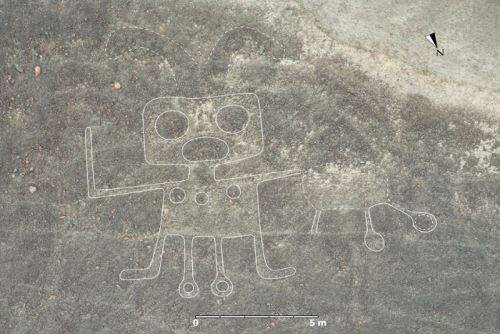Scientists from Japan's Yamagata University discovered 303 new geoglyphs during a 6-month fieldwork in Nazca Pampa, where the emblematic Nazca Lines geoglyphs (such as the Monkey and the Spider) are located, thanks to the help of artificial intelligence (AI) that accelerated the work of specialists in the field.
Sakai said the discovery was the result of a pilot experiment involving 10 people and conducted in collaboration with U.S. company IBM.
The scientist pointed out that the total number of geoglyphs found is 303, which is added to the 430 found previously. In total, there are 733 in Nazca Pampa. Nonetheless, he specified that so far only 30% of the total has been explored, and 70% still remains to be worked on, which will require more time.
These giant linear geoglyphs predominantly depict wild animals. They are distributed along an elaborate network of linear and trapezoidal geoglyphs and were in past times probably used for community ritual activities.
The small relief geoglyphs depict motifs related to human activity, where humans and domesticated camelids can be distinguished. They are commonly located a short distance from winding paths, Yamagata explained.
The average size of the new geoglyphs is 9 meters. There may be larger or smaller ones, but that is the average, he pointed out.
The Japanese scientist said that since 2004 Yamagata University has conducted research on the "Nazca Geoglyphs."
Through long-term fieldwork, the main objective of this study is to collect essential data on the geoglyphs in order to eventually understand the purpose of their use and execution.
The Yamagata University professor indicated that, thanks to remote sensing technologies (such as satellite images, aerial photographs, and image captures with drones), extensive field studies have been conducted in Nazca Pampa, covering an area of approximately 400 square kilometers, which have been fed into AI to ultimately locate the geoglyphs.

Sakai noted that, given the confirmation of such a large number of figurative geoglyphs, rarely observed, and that there is still much to discover in Nazca Pampa, it is necessary to implement more efficient methods to understand their distribution.
The expert said that in order to improve both the accuracy and speed of research, the integration of artificial intelligence (AI) was implemented.
"The traditional method of study, which involved visually identifying geoglyphs from high-resolution images of this vast area, was slow and carried the risk of missing some of them. However, the use of AI in this research has enabled us to map the distribution of geoglyphs in a faster and more accurate way," he added.
(END) JCB/MAO/MVB
Published: 9/24/2024